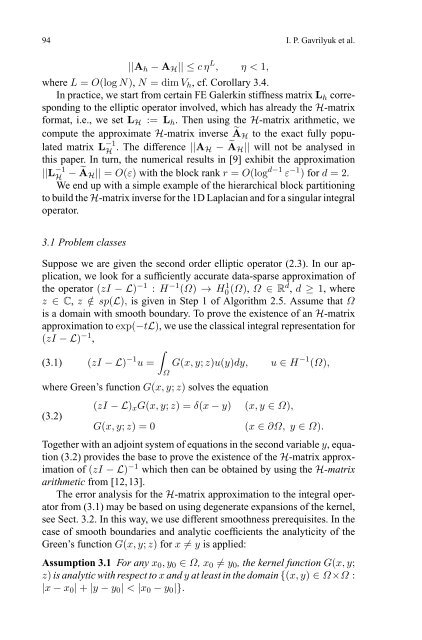H-Matrix approximation for the operator exponential with applications
H-Matrix approximation for the operator exponential with applications
H-Matrix approximation for the operator exponential with applications
Create successful ePaper yourself
Turn your PDF publications into a flip-book with our unique Google optimized e-Paper software.
94 I. P. Gavrilyuk et al.<br />
||A h − A H || ≤ cη L , η < 1,<br />
where L = O(log N), N = dim V h , cf. Corollary 3.4.<br />
In practice, we start from certain FE Galerkin stiffness matrix L h corresponding<br />
to <strong>the</strong> elliptic <strong>operator</strong> involved, which has already <strong>the</strong> H-matrix<br />
<strong>for</strong>mat, i.e., we set L H := L h . Then using <strong>the</strong> H-matrix arithmetic, we<br />
compute <strong>the</strong> approximate H-matrix inverse ÃH to <strong>the</strong> exact fully populated<br />
matrix L −1<br />
H . The difference ||A H − ÃH|| will not be analysed in<br />
this paper. In turn, <strong>the</strong> numerical results in [9] exhibit <strong>the</strong> <strong>approximation</strong><br />
||L −1<br />
H − ÃH|| = O(ε) <strong>with</strong><strong>the</strong> block rank r = O(log d−1 ε −1 ) <strong>for</strong> d =2.<br />
We end up <strong>with</strong> a simple example of <strong>the</strong> hierarchical block partitioning<br />
to build <strong>the</strong> H-matrix inverse <strong>for</strong> <strong>the</strong> 1D Laplacian and <strong>for</strong> a singular integral<br />
<strong>operator</strong>.<br />
3.1 Problem classes<br />
Suppose we are given <strong>the</strong> second order elliptic <strong>operator</strong> (2.3). In our application,<br />
we look <strong>for</strong> a sufficiently accurate data-sparse <strong>approximation</strong> of<br />
<strong>the</strong> <strong>operator</strong> (zI −L) −1 : H −1 (Ω) → H0 1(Ω), Ω ∈ Rd , d ≥ 1, where<br />
z ∈ C, z /∈ sp(L), is given in Step 1 of Algorithm 2.5. Assume that Ω<br />
is a domain <strong>with</strong>smoothboundary. To prove <strong>the</strong> existence of an H-matrix<br />
<strong>approximation</strong> to exp(−tL), we use <strong>the</strong> classical integral representation <strong>for</strong><br />
(zI −L) −1 ,<br />
∫<br />
(3.1) (zI −L) −1 u = G(x, y; z)u(y)dy, u ∈ H −1 (Ω),<br />
Ω<br />
where Green’s function G(x, y; z) solves <strong>the</strong> equation<br />
(zI −L) x G(x, y; z) =δ(x − y) (x, y ∈ Ω),<br />
(3.2)<br />
G(x, y; z) =0<br />
(x ∈ ∂Ω, y ∈ Ω).<br />
Toge<strong>the</strong>r <strong>with</strong> an adjoint system of equations in <strong>the</strong> second variable y, equation<br />
(3.2) provides <strong>the</strong> base to prove <strong>the</strong> existence of <strong>the</strong> H-matrix <strong>approximation</strong><br />
of (zI −L) −1 which <strong>the</strong>n can be obtained by using <strong>the</strong> H-matrix<br />
arithmetic from [12,13].<br />
The error analysis <strong>for</strong> <strong>the</strong> H-matrix <strong>approximation</strong> to <strong>the</strong> integral <strong>operator</strong><br />
from (3.1) may be based on using degenerate expansions of <strong>the</strong> kernel,<br />
see Sect. 3.2. In this way, we use different smoothness prerequisites. In <strong>the</strong><br />
case of smooth boundaries and analytic coefficients <strong>the</strong> analyticity of <strong>the</strong><br />
Green’s function G(x, y; z) <strong>for</strong> x ≠ y is applied:<br />
Assumption 3.1 For any x 0 ,y 0 ∈ Ω, x 0 ≠ y 0 , <strong>the</strong> kernel function G(x, y;<br />
z) is analytic <strong>with</strong> respect to x and y at least in <strong>the</strong> domain {(x, y) ∈ Ω×Ω :<br />
|x − x 0 | + |y − y 0 | < |x 0 − y 0 |}.
















